|

The 191st Aihkiniemi DXpedition
was a mix of fun and radio silence. During the first
week, conditions on the dial were at least mediocre,
and we also spent a couple of days traveling in
Norway. However, a burst of protons later hit Earth's
magnetosphere, disrupting long-distance reception
on the AM band. For nearly a week, no stations from
across the Atlantic or the Far East were heard.
The logistics
of the first DXpedition of the season were more
complicated than usual: three DXers, two cars transported
by train on separate days, and one airplane arrival.
First, Jarmo Salmi brought some of his gear to me,
which I took to Lapland by train on October 18.
I loaded my car on the train in Helsinki on Friday
evening. I was busy with work until the last minute,
completing two lengthy reporting projects and picking
up equipment from the Yle HQ in Pasila for my next
reporting assignment in the US.
Just before the train's departure, I met fellow
DXers Hannu Tikkanen and Håkan Sundman for
pizza at Ristorante Limone in the Mall of Tripla
in Pasila. Hannu boarded the same train, as he was
heading to a similar long DXpedition in Lemmenjoki.

Hannu, Håkan and me
at Ristorante Limone before departure.
On Saturday morning, our train
arrived in Rovaniemi 52 minutes late — just
shy of the one-hour mark that would have entitled
us to a partial refund. I didn’t mind the delay,
though, as it gave me a chance to catch up on sleep.
I never sleep very well on trains.
The weather was exceptionally warm, well above freezing.
Despite encountering several large herds of reindeer
crossing the road along the way, the drive was smooth
and effortless. I stopped for a salmon sandwich
in Sodankylä, picked up some wine at the northernmost
Alko in Ivalo, and later refueled and bought groceries
in Inari.

Kaunispää is the
only mountaintop in Lapland where you can drive,
offering beautiful views from the summit for a busy
traveler. CLICK the photos
in this report to see them in full size in a new
browser window.
I arrived in Aihkiniemi at 14:25
local time under bright sunshine. The first evening
is always busy, as I worked to set up an optimal
configuration to operate three SDR receivers simultaneously.
As before, I used Perseus receivers
controlled by the excellent Jaguar software developed
by Ilpo Parviainen and enhanced with a top-notch
antenna splitter and amplifier built by Stefan Wikander.
Without this equipment — and, of course, the
fantastic Aihkiniemi cabin — my AM DXing would
be significantly more challenging and far less productive.
For more about DXing
in Lapland and the Aihkiniemi cabin, first check
out this BBC
video, then my nerdier video introduction on
YouTube,
and this detailed article
on DXing.info.

The two Aihkiniemi cabins
in mid-October.
While sorting through the tangle
of wires, I discovered some surprising connections
in the cabin: the main Perseus power source was
connected to a faulty UPS, and another Perseus power
cable was hooked up to a 12V power source. Hopefully,
no one has damaged their Perseus by neglecting to
check the voltage first.
Another task was resolving a WLAN issue at a new
remote listening site nearby, which I had set up
with Jari Luoma and Timo Metso just two weeks earlier.
The site features a remote-controlled 1,250-meter-long
Beverage antenna aimed at 302 degrees, designed
to catch stations from the East Coast of North America.
Unfortunately, I brought the wrong cable, so I had
to drive to the village of Partakko to borrow an
HDMI cable to access one of the mini PCs. Thankfully,
the issue was resolved, and I was able to return
to Aihkiniemi.
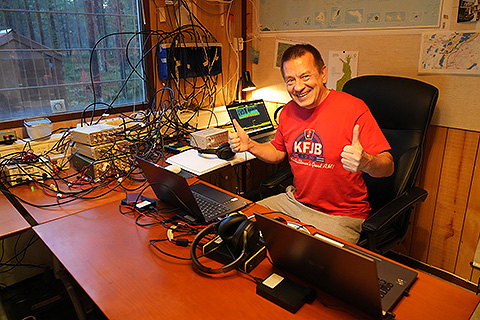
Always happy to be DXing in
Aihkiniemi!
With that task completed, it
was time for a well-deserved sauna and to organize
all my belongings in the rather cramped cabin.
I had no idea what kind of stations might emerge
from the East, but I recorded the entire AM band
from 1325 UTC onward just in case. Judging by the
South Asian sounds on a few frequencies, it seemed
unlikely there would be anything extraordinary.
For example, I did spot ABC on 891 AM — common
enough in Aihkiniemi.

The Milky Way shot on
the road (above) and on the shore of the newly-frozen
lake next to our cabin (below).
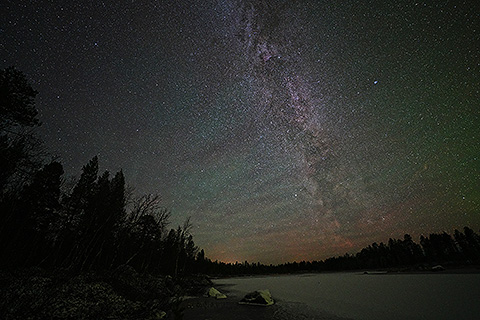
In my DXing endeavors, I utilized three Perseus
SDR receivers paired with Jaguar software. A selection
of 13 permanently installed Beverage-type antennas,
each approximately 1 kilometer (3,300 feet) long,
were strategically aimed to maximize signal reception
from all key target areas of interest:

Sunday,
October 20, 2024
I woke up in the middle of the
night and, not hearing anything from the west, decided
to check how Indian stations sounded at the start
of their broadcast day. Unsurprisingly, there was
nothing noteworthy. Eventually, the western front
rose above the static, and sunrise conditions turned
out to be better than they had been the entire previous
week. The opening centered around Iowa and Minnesota,
so the stations were mostly very familiar.
As the morning progressed, the
reception path shifted westward, and some Pacific
Northwest stations intermittently emerged during
the daytime. Among the stations I identified were
1260 WSDZ IL and 1450 KGIW CO.
During the daylight hours, I checked the antennas
aimed at 255 and 270 degrees. It was a sweaty task,
as the weather remained unseasonably warm.
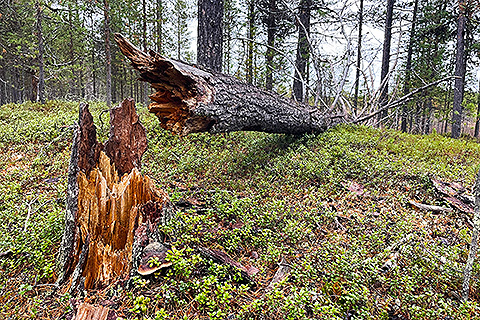
Stations from Asia were coming
through quite well from around 1200 UTC, but I didn’t
log any new catches. It was time for a sauna and
a nap. Among the identified stations were 1413 Hegang
PBS, 1521 JOAD NHK2 Okinawa relay, and 1539 JOTB
NHK2 Matsue relay. The only personally new station
I identified immediately was Voglia di Radio from
Italy on 1071 AM.
Monday, October 21, 2024
Some North American signals were
heard throughout the night but suffered from heavy
European interference. After daybreak, signals remained
fairly strong for a couple of hours until 0830 UTC,
after which only a handful of stronger stations
could still be found on the dial. For example, 1240
WENK TN, 1400 KIHH CA, and 1570 WSCO WI were logged.
DXer Matthew King, who lives
relatively close in Inari, about 60 km away, came
over for a brief visit — his first time in
Aihkiniemi — at daybreak to check out the conditions.
He was quite amazed at the signal levels, with stations
on practically every channel, since at home, KBRW
Barrow AK (680 AM) was the only American station
he had managed to hear so far with his random wire
antenna. After this DX booster shot, he later heard
several more North American stations at home on
the same day.

Matthew King testing the
Aihkiniemi equipment.
After Matthew headed home, I
ventured into the forest. The morning fog had dissipated,
and the weather felt quite refreshing, although
it was still cloudy. I checked two more of our antennas
(291 and 304 degrees), hiking a total of four kilometers
in an hour. One of the supporting poles needed some
improvement, but otherwise, the antennas were fine.
When I returned at 0930 UTC,
many Japanese stations and V7AB Radio Marshall (1098
AM) were already audible. However, I noticed that
the 30-degree wire was considerably noisier than
the others. Replacing a coaxial cable between the
wall mount and the splitter solved the issue. On
the rather rare occasion when Japanese NHK stations
were audible at 1000 UTC, at least in the upper
end of the dial, I caught one new station for me
personally, a low-power relay of JOFP Fukushima
on 1368 AM.
The opening to Asia turned out
to be brief, and signals from the East nosedived
for several more hours, which is a rather rare setback.
In the evening, there wasn't
much to listen to, but that wasn't a problem, as
Jim Solatie and his wife Pia arrived with their
Labrador retriever, Mocca. We had lots to talk about
over some dessert goodies. Jim would be DXing with
me in Aihkiniemi for part of this first week.

Mika, Pia and Jim, who all love Aihkiniemi!
Tuesday, October 22, 2024
Overnight conditions were very
weak for Latin America, and North America was also
weaker than on the previous night. Conditions favored
the Midwest, including South Dakota and Kansas,
and extended all the way to the Rockies. Identified
stations included 1240 KFBC WY, 1400 KCOW NE, and
1450 WLEC OH.
It was time to take a three-day/two-night
break from DXing, with an itinerary planned by Jim
and Pia. Once again, Norway was calling us. This
has become a bit of an October tradition by now,
but on three previous occasions, during AIH142
in 2021, AIH159
in 2022 and AIH176
in 2023, we stayed in Norway for just one night.
After 1000 UTC, we started driving north, with Jim
at the wheel. Our first stop was at a supermarket
in Näätämö, near the Norwegian
border, where we discovered a surprise: they had
a new kind of snack made from cold-smoked bear meat.
Incidentally, that particular bear had been shot
in mid-September at Siuttajoki, which is just a
couple of kilometers from the Aihkiniemi cabin!
It was local and indigenous food, but extremely
expensive. Still, I couldn't resist buying a hefty
supply of these bear meat sticks to give as gifts
with a unique story.
Our primary destination was Kongsfjord
on the northern edge of Finnmark, where fellow DXers
Bjarne Mjelde, Odd-Jørgen Sagdahl, and Ole
Forr were enjoying their annual October DXpedition
(KONG49).
Before that, we planned to go hiking near Berlevåg.
Our first stop in Norway was
a Rema store in Tana bru for some groceries and
a Shell service station next door for a light meal.
Afterwards, we continued north across the Varanger
Peninsula to Berlevåg, a remote fishing hamlet
on Norway's northernmost coast.
Ideally, we would have stayed
overnight in Kongsfjord, but this time the Kongsfjord
Arctic Lodge was closed, so we had to stay at Berlevåg
Motel, a 30-km and 30-minute drive further north
of Kongsfjord. Their more affordable section was
a pension-type guesthouse, where we had a public
living room all to ourselves. There wasn't much
to see in the town itself, but we enjoyed a good
hamburger and ribs dinner at the best — and
probably only — eatery in town, Restaurant
Oliver. And we had some wine later at the motel.
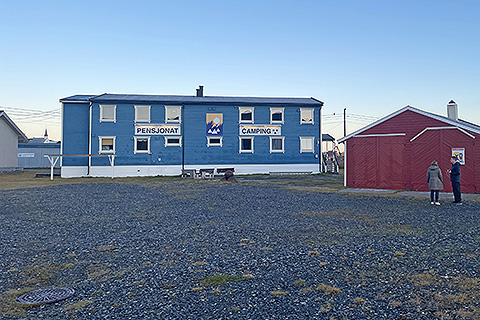
Our modest but clean accommodation
in Berlevåg.
Wednesday,
October 23, 2024
After a hearty breakfast, it
was necessary to burn some calories. West of Berlevåg
stands Tanahorn, an impressive rocky outcropping
facing the Barents Sea. We left Jim's Honda at the
trailhead on a remote road and completed a 7.5-kilometer
hike in three hours.
There were endless photo opportunities, as the weather
was unusually un-Norwegian — bright, calm,
and even warm, considering the time of the year.
Some fog was rolling in from the sea, but at our
location, it remained sunny. Only a few isolated
patches of snow were visible higher up in the mountains,
but otherwise, it seemed as if it could have been
summer. Our trail was mostly surrounded by crowberry,
an evergreen shrub, so even the vegetation didn't
change with the season.

Photos from Tanahorn; Mika at the top, the end of
the trail (middle), and the Solatie family (bottom).


Afterwards, we took more photos
at Store Molvik, an old village now composed only
of summer cottages. On the way to Store Molvik,
there was a small, nameless lake as calm as a mirror
— another fabulous scene to capture in memory.

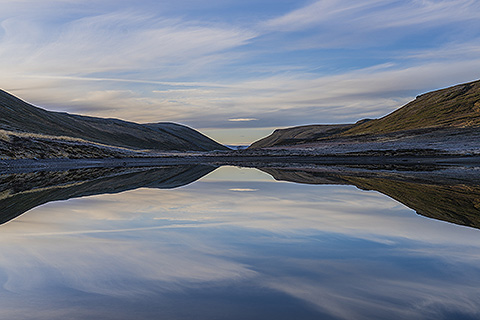

Crowberry covers the moor
by the by the sea in Store Molvik.
Afterwards, we took a shower
and an afternoon nap before the highlight of the
excursion: a king crab dinner at KONG. In addition
to the largest crabs, other delicacies included
goose liver pâté, pasta carbonara,
and a cheese selection followed by chocolate mousse,
all paired with fine wines.
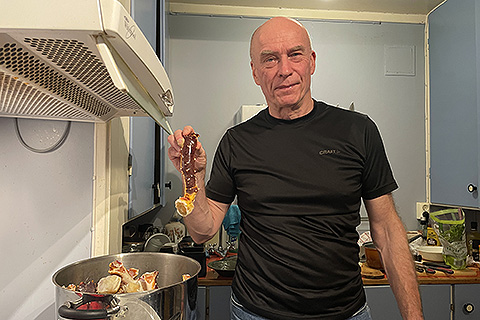
Bjarne cooking the king crab
and below Jim taking photos of our meal.

As usual, there was plenty of DX talk, despite the
less-than-ideal DX conditions this week — or
likely for the entire winter, given that we are
approaching the peak of the 11-year solar cycle.
Unsurprisingly, we saw the northern lights over
the fjords as Pia kindly drove the three of us back
to Berlevåg in the early hours of Thursday.
Thursday, October 24, 2024
Waking
up after yesterday's feast in Kongsfjord wasn't
as smooth as usual, but we managed to make it to
the hotel restaurant for breakfast, check out, and
drive to Kongsfjord. In Berlevåg, it was raining
a bit and very windy along the route, but once we
reached Kongsfjord, the sun partially returned,
and the wind was much calmer.
We hiked with the KONG
crew to the end of Veines, where we first saw a
small shelter built for birdwatching. Along the
way, we explored many ruins of a World War II-era
German coastal fort. Much of it had eroded to rubble,
but some of the concrete fortifications still looked
quite sturdy.

Sandfjorden is a beautiful
bay named after its sandy beach, located between
Berlevåg and Kongsfjord.

In the very end of the peninsula,
Veinesodden, stood a small newish lighthouse guarding
the last speck of land before Alaska on the opposite
side of the Arctic Ocean.

Above Jim, OJ, Ole, Mika
and Bjarne at the lighthouse. Below the blue house
is Bjarne's DX headquarters.

After a 6-kilometer, 2-hour hike,
we returned to Bjarne's cabin for a hearty brunch,
complete with some leftover king crab, cold-smoked
salmon, and artisan raspberry jam made by Odd-Jørgen.
Then it was time to say goodbye to our friends and
start driving south. The road conditions remained
perfect, with temperatures above the freezing point.
We stopped for groceries at Extra in Tana bru and
picked up some smoked fish as well as fish balls
from Røberg Fisk og Kjøtt.

There were lots of reindeer on
the road south of Utsjoki on the Finnish side, but
we made it safely to Aihkiniemi, where we began
trying to make sense of the automated recordings
from the previous three days.
Apparently, there had been loads of Asian stations
on the dial on Wednesday, so there will be plenty
of recordings to review. On the same morning, CC158
Radio Colchagua from Chile on 1580 AM was a neat
surprise.
Friday, October 25, 2024
Overnight
conditions were poor, with mostly just a handful
of Brazilian and Argentinian stations on the dial
for a couple of hours. Around daybreak, this opening
extended northwards to Peru and Colombia, but there
were rather few stations from the US East Coast.
Jim and Pia packed their car
and left to take care of Jim's remote listening
station in Repojoki in Western Lapland. I continued
checking antennas in Aihkiniemi under bright sunshine.
Today's 4-kilometer maintenance hike took me along
Beverage wires pointed at 335 and 321 degrees, where
I found a lone glove, lost by one of the previous
DXers in Aihkiniemi.
The dial was quiet during the daytime, but Chinese
and South Asian signals began seeping in around
1200–1300 UTC.
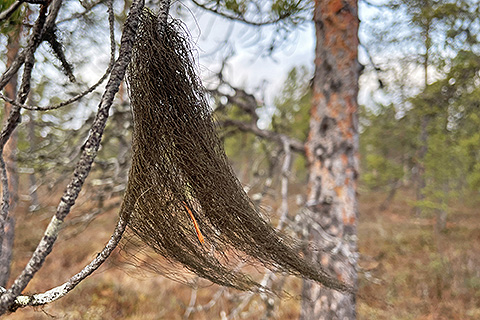
Beard moss on trees is a sign
of exceptionally clean air.
Saturday, October 26, 2024
Solar
conditions took a turn for the worse, with proton
flux increasing for the second day in a row. Protons
are an absolute killer up north, effectively severing
all propagation paths across Arctic regions. As
a result, only a few weak North American signals
were heard at sunrise, and even Latin American stations
were barely audible.
Most of Saturday was spent on
the road. I drove for 1.5 hours to the airport in
Ivalo to pick up Jarmo Salmi, who joined me for
the second week of DXpedition AIH191. We enjoyed
a massive double burger at Restaurant Ivalo and
did our grocery shopping at K-Supermarket. We returned
to Aihkiniemi just before dark, but Jarmo was in
no hurry to set up his equipment, as there wasn't
anything interesting to listen to.
And it would only get worse.

A GOES satellite measures
protons hitting Earth's magnetosphere. Anything
above the stable baseline is bad news for AM DXing.
This data for the duration of my two week DXpedition
clearly shows how conditions were normal during
the first week and abysmal during the second week.
Sunday, October 27, 2024
Overnight,
not a single station was audible from across the
Atlantic. I can't remember the last time we experienced
such a complete absence of DX stations. The reason
was obvious: proton levels had crept to even higher
levels. Only some European stations remained on
the dial in the morning, and not a single AM station
was heard during daylight hours.
Before midday, Jarmo and I continued
checking antennas and walked along those pointing
at 10, 30, and 46 degrees. The water levels in the
swamps were quite high, making walking treacherous.
At one point, I was blinded by the sun and couldn't
quite see where I was stepping, ending up knee-deep
in water. Fortunately, my boots were quite tight,
so I didn't get too wet.
In the late afternoon, only stations
from Central Asia and the Middle East were audible,
with none from East Asia. The protons were to blame.
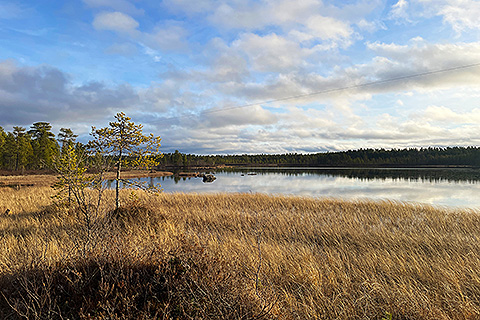
The end of our 46-degree antenna.
Monday, October 28, 2024
Again, there were no Transatlantic
signals at all. Luckily, I finally identified Radio
Islam International from South Africa on 1548 AM
after 0200 UTC and received an email QSL immediately
in response to my reception report. Otherwise, there
wasn't much to listen to.
It rained throughout the day,
so we postponed the remaining antenna chores. Jarmo
improved the insulation of the new cabin.
In the evening, we installed
a new splitter-amplifier in Aihkiniemi. This very
professional setup was courtesy of Ismo Kauppi,
who kindly donated it to Aihkiniemi. All incoming
and outgoing connections are now BNC, making all
outgoing cables much easier to connect. We now have
13 Beverage antennas in use, but the splitter has
room for many more.
Then there was an accident. While
reorganizing all the cables, one of my Perseus receivers
got disconnected from the power source for a second,
causing something to go awry inside the hardware.
Despite many attempts, including changing all cables
and reinstalling the software, I wasn't able to
get it working. Apparently, I need to send it to
Microtelecom in Italy for repairs.

Jarmo Salmi DXing in Aihkiniemi.
Tuesday, October 29, 2024
More of the same — under
proton fire, the strongest since early June, the
AM band continued to be comatose with nothing to
listen to overnight.
Here's what Spaceweather.com
reported: "PROTONS ARE RAINING DOWN ON EARTH:
For the 3rd day in a row, energetic protons are
raining down on Earth. It's an S2-class radiation
storm. The protons were accelerated by X-class solar
flares on Oct. 24th and 26th. As a result of the
storm, a shortwave radio blackout is underway inside
the Arctic Circle, and cameras on spacecraft are
being fogged. Indeed, most of the speckles in the
SOHO coronagraph movie highlighted below are solar
protons hitting the camera. This could continue
for at least another 24 hours."
During the day, we inspected
and slightly improved the last remaining antennas.
As darkness fell around 1400 UTC, stations from
the Middle East — mostly just reciting the
Koran — began to invade the airwaves. It's
tough to find anything new from there.
Late in the evening, we enjoyed
the first spectacle of northern lights. There was
some moisture in the air, so they weren't as clear
as they could have been, but they were still an
awesome sight.


Wednesday, October 30, 2024
Overnight, we received the first
snow, just enough to cover the ground in white.
As for radio propagation, there was no improvement.
Proton levels remained far too high to hear anything
meaningful.
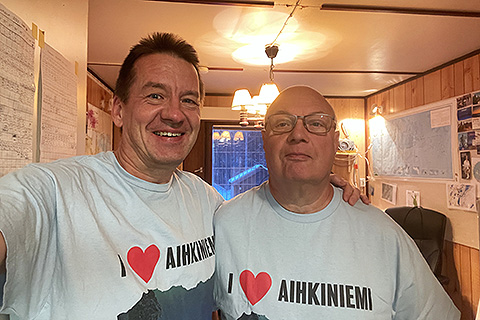
Mika and Jarmo at Aihkiniemi.
Thursday,
October 31, 2024
At -12°C the morning was
the coldest so far. Reception didn't really improve,
although we did spot the first Transatlantic station
(Brazil on 940 AM) in six days. I have hardly any
notes from this day. I instantly deleted all files,
except for recordings made on the 207-degree wire,
which I hoped could catch some low-power stations
from the Netherlands.
Friday, November 1, 2024
More of the same —
American signals remained elusive, and the furthest
we could reach towards Asia in the afternoon was
India. We spent our time fixing things, listening
to earlier recordings, and packing.
Saturday, November 2, 2024
Under the relentless bombardment
of protons, there wasn't much point in listening
to the AM dial. Once again, the 207-degree wire
was the only one that might yield something of interest.
We packed and left early, before midday, so at least
there was ample time to stop along the way for photos,
some of which you can see below.

Downtown Inari.
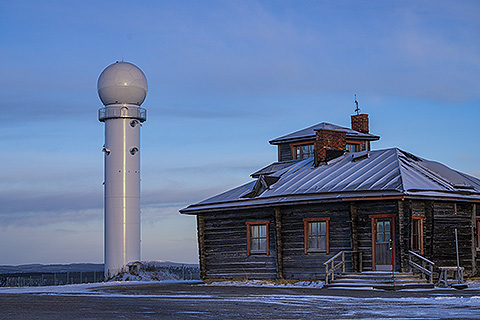
A new weather radar at
the summit of Kaunispää.

Reindeer crossing the
highway.
Although the roads were partially
icy, the weather was otherwise perfect, and we reached
Rovaniemi well ahead of the train's departure. From
the abundant restaurant scene, we chose the hamburgers
at Kauppayhtiö for dinner, and we had time
to walk around downtown, including visiting the
Jätkänkynttilä Bridge below.

We boarded the train
on time, but the journey got off to an unlucky start
as the engine broke down immediately. It took two
hours to get a replacement, but we nevertheless
arrived in Helsinki according to schedule. On Sunday
morning, I drove Jarmo to his home in Nurmijärvi
and then continued home myself, only to repack right
away and fly to the US to cover election day. We
all know how that turned out. At least foreign news
journalists will have plenty to report on during
the upcoming four years.
A comprehensive log will be added as soon as I have
reviewed all recordings made during these two weeks.
Text
and photos: Mika
Mäkeläinen
Published on December
29, 2024
  
|